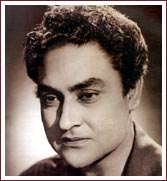
HOME | MOVIES | FEEDBACK |

Certain stars are closely associated with the period that they were famous in, and their success is redolent of a particular time.
Ashok Kumar, born Kumudlal Kunjilal Ganguly, got into acting by happenstance.
Hindi movies in the mid 1930s had started talking barely five years ago. Himanshu Rai had started the ambitious Bombay Talkies Studio which with educated people. Ashok Kumar, a law student from Kolkata, wanted to become a director so he joined Rai as a laboratory assistant. Ashok's brother-in-law, Shashadhar Mukherji (later the doyen of Filmistan and Filmalaya Studios, Mumbai) was already with Bombay Talkies.
When Rai needed a hero, he thrust a protesting Kumar in front of the camera opposite his wife Devika Rani in
Jeevan Naiyya (1936). There were objections from Ashok's family (his father was a lawyer and his grandfather, a very moneyed district magistrate). But Bombay Talkies was prestigious and Ashok plunged into performance at a princely salary of Rs 75 per month.
His acting, however, was very raw. For one scene where he had to garland the intimidating and polished Devika Rani, he kept getting the garland entangled in her hair.
1936 was also momentous for Ashok because he acceded to an arranged match with Shobha.
In the same year, Devika Rani and Ashok came together again for the smash hit -- Achhut Kanya (1936). Ashok's Main ban ki
chidiya is probably one of the earliest songs still in public memory. The film was seem more as Devika's success while Ashok was slotted as a chocolate hero.
But soon, S Mukherji produced for Bombay Talkies three silver jubilee films between 1939 and 1941 starring Ashok Kumar and Leela Chitnis -- Kangan, Bandhan and Jhoola (Kamal Haasan sings about this trio in Ek Duje Ke Liye). Ashok picked up valuable acting tips from the stage-trained Leela Chitnis. These films, adorned with Saraswati Devi's hit music, made him a true blue star.
The mega blockbuster Kismet (1943) proved Ashok's crowning glory -- and ironically his last film at Devika Rani's Bombay Talkies. A precursor to the famous lost-and-found formula, Kismet brought to fore an exciting, new, grey-shaded hero who is glib, streetsmart and not above stealing from the rich to finance the poor.
Propelled by this startlingly revisionist, modern hero, and Ashok's exuberant, stylised performance (the cigarette became his trademark), Kismet ran for three years in
Kolkata.
Thereafter, Ashok forsook Bombay Talkies (after Himanshu's death in 1940, the studio split into factions), and became a freelance artiste. World War II was at its height and the studio system was breaking up. But S Mukherji started Filmistan along with Ashok.
Some years later, when Bombay Talkies was up for sale, Ashok bought his beloved studio. Among the first things he did was to institute a bust of mentor Himanshu Rai.
It is not hard to believe Ashok when he says that he came to films to be a filmmaker. Because soon after his Kismet glory days, he cut down on his acting assignments and concentrated on making films. Producers clamoured for him (it is said that Mehboob Khan who worked with Ashok in Najma and Humayun wanted him for Andaaz too), but even for a Bombay Talkies film like Ziddi, Ashok begged off and instead cast newcomer Dev Anand as the hero.
The emergence of the Raj Kapoor-Dilip Kumar-Dev Anand trio and the realisation that he would not be able to keep Bombay Talkies afloat for long saw Ashok concentrate again on his acting career. He had successes like Mahal (1949) and Samadhi (1950). In 1951 he had three releases -- Afsana, Sangram and Deedar. All three were successful.
In the 1950s, when Devika Rani retired and Leela Chitnis opted for mother's roles in Awara, Ashok teamed with younger heroines like Nalini Jaywant (10 films) and Meena
Kumari (14 films). He acted in dark crime thrillers like Sangram or Howrah Bridge or show depth as the lover in Bimal Roy's Parineeta or the
hero who marries a widow in B R Chopra's Ek Hi Raasta.
His costars may have been the current box office hotties but Ashok Kumar continued to get top billing. He was already a legend. Awards and citations started pouring in. A Padmashri in 1962, a Filmfare Award for Rakhi (1962) and a National Award at the ripe retirement age of 58 for Aashirwad (1968).
Ashok gamely experimented with his roles. In Aarti, Jewel Thief and Jawab (where he rapes Meena Kumari), he played villainous roles. In Victoria No 203 and Shaukeen, he played variations of the naughty old man.
But perhaps he was most enduring and identifiable as the patriarch in films like Mili, Khoobsurat and Anuraag. He exuded warmth and wisdom.
In the late 1980s, his health deteriorated and he cut down his workload, consenting to do the occasional Return Of Jewel Thief (1996). He had long cultivated passions like painting (he painted in his bathroom), astrology and homeopathy. He spent his last years in his Chembur bungalow (a Mumbai
suburb), battling asthma.
In the 1940s, his sister Sati had called him Dadamoni (an elder brother who is like a jewel) and the name caught on. On December 10, 2001, at the age of 90, when Ashok Kumar passed away, he was truly the industry's Dadamoni.
You might also want to read:
|
||
(c) 1996 - 2002 rediff.com India Limited. All Rights Reserved. |
|||